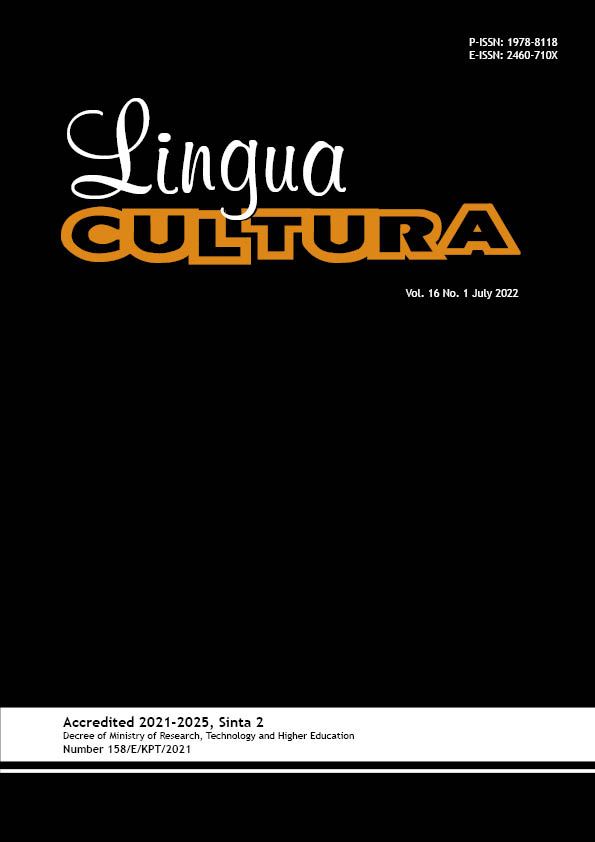Syntactic Complexity of Online Opinion Articles Published in South East Asian Countries
DOI:
https://doi.org/10.21512/lc.v16i1.7827Keywords:
syntactic complexity, online opinion articles, published articles, d-analyzerAbstract
The research investigated the syntactic complexity of opinion articles published in online newspapers from English as a Second Language (ESL) and English as a Foreign Language (EFL) countries in South-East Asia (SEA). The aims of the research were, first, to analyze the types of Syntactic Complexity (SC) of opinion articles in online news media. The second was to seek the difference in syntactic complexity in online opinion articles between ESL and EFL countries. The third was to seek whether there was a significant difference in terms of types of syntactic measurements between ESL and EFL countries. To answer the questions, the research applied both quantitative and qualitative methods. Twelve opinion articles from online news media in SEA countries were derived from Malaysia and Singapore, which represented ESL countries, and Indonesia and Thailand, which represented EFL countries. The data were analyzed by using an L2 syntactic complexity analyzer. The Second Language Syntactic Complexity Analyzer (L2SCA) program displayed fourteen syntactic complexity measures divided into five types of measurements such as the length of production, sentence complexity, subordination, coordination, and particular structures. From comparing overall ESL and EFL countries and each of the opinion articles topics, the research results reveal that opinion articles of ESL countries show a higher score on the length
of production, sentence complexity, subordination, and particular structures than EFL countries. Meanwhile, in coordination type, EFL countries display a higher number of a score than ESL ones. The research indicates there is no significant difference between ESL and EFL countries since the p-value of each type of syntactic complexity is higher than 0,05.Â
References
Abu-Ayyash, E. A. S. (2020). Context and culture via cohesive devices in higher education students’ and professional writers’ opinion articles. GEMA: Online Journal of Language Studies, 20(1), 106-120.
Ai, H., & Lu, X. (2013). A corpus-based comparison of syntactic complexity in NNS and NS university students’ writing. In N. B. & P. T. A. Diaz-Negrillo (Ed.), Automatic treatment and analysis of learner corpus data (pp. 249-264). Amsterdam: John Benjamins Publishing Company.
Al-Rickaby, A. K. (2020). A critical discourse analysis of stance and engagement markers in English and Arabic newspaper opinion articles in 2016. Journal of University of Babylon for Humanities, 28(4), 182-194.
Bardovi-Harlig, K. (1992). A second look at t-unit analysis: Reconsidering the sentence. TESOL Quaterly, 26(2), 390-395. https://doi.org/10.2307/3587016.
Casal, J., & Lee, J. (2019). Syntactic complexity and writing quality in assessed first-year L2 writing. Journal of Second Language Writing, 44, 51-62. https://doi.org/10.1016/j.jslw.2019.03.005.
Dewi, D. (2019). The illocutionary acts of environmental persuation in U.S. online newspaper opinion articles. Beyond Words: A Journal on Applied Linguistics and Language Education, 7(2), 101-121. https://doi.org/10.33508/bw.v7i2.2151.
Hunt, K. W. (1970). Do sentences in the second language grow like those in the first? TESOL Quaterly, 4(1), 195-202. https://doi.org/10.2307/3585720.
Indarti, D. (2018a). Pattern of rhetorical organization in The Jakarta Post opinion articles. Siele: Studies in English Language and Education, 5(1), 69-84. https://doi.org/10.24815/siele.v5i1.8535.
Indarti, D. (2018b). Syntactic complexity of online newspaper editorials across countries. Studies in English Language and Education, 5(2), 294-307. https://doi.org/10.24815/siele.v5i2.11320.
Khusik, G., & Huhta, A. (2020). Investigating syntactic complexity in EFL learners’ writing across common European framework of reference levels A1, A2, and B1. Applied Linguistics, 41(4), 506-532. https://doi.org/10.1093/applin/amy064.
Kuiken, F., & Vedder, I. (2019). Syntactic complexity across proficiency and languages: L2 and L1 writing in Dutch, Italian and Spanish. International Journal of Applied Linguistics, 29(2), 192-210. https://doi.org/10.1111/ijal.12256.
Kyle, K., & Crossley, S. (2018). Measuring syntactic complexity in L2 writing using fine-grained clausal and phrasal indices. Modern Language Journal, 102(2), 333-349. https://doi.org/10.1111/modl.12468.
Lu, X. (2010). Automatic analysis of syntactic complexity in second language writing. International Journal of Corpus Linguistic, 15(1), 474-496. http://dx.doi.org/10.1075/ijcl.15.4.02lu.
Lu, X., & Ai, H. (2015). Syntactic complexity in college-level English writing: Differences among writers with diverse L1 backgrounds. Journal of Second Language Writing, 29(1), 16-27. https://doi.org/10.1016/j.jslw.2015.06.003.
Oktavianti, I. N., & Adnan, A. (2020). A corpus study of verbs in opinion articles of The Jakarta Post and the relation with text characteristics. English Language Teaching Educational Journal, 3(2), 108-117. https://doi.org/10.12928/eltej.v3i2.2158.
Rajadurai, J. (2005). Revisiting the concentric circles: conceptual and sociolinguistic consideration. The Asian EFL Journal, 7(4), 111-130.
Saricaoglu, A., Bilki, Z., & Plakans, L. (2021). Syntactic complexity in learner-generated research paper introductions: Rhetorical function and level of move/step realization. Journal of English for Academic Purposes, 53, 101037. https://doi.org/10.1016/j.jeap.2021.101037.
Shen, Q., & Tao, Y. (2021). Stance markers in English Medical research articles and newspaper opinion columns: A comparative corpus-based study. PLoS ONE, 16(3), 1-22. https://doi.org/10.1371/journal.pone.0247981.
Downloads
Published
How to Cite
Issue
Section
License
Copyright (c) 2022 Dwi Indarti, Muarif

This work is licensed under a Creative Commons Attribution-ShareAlike 4.0 International License.
Authors who publish with this journal agree to the following terms:
a. Authors retain copyright and grant the journal right of first publication with the work simultaneously licensed under a Creative Commons Attribution License - Share Alike that allows others to share the work with an acknowledgment of the work's authorship and initial publication in this journal.
b. Authors are able to enter into separate, additional contractual arrangements for the non-exclusive distribution of the journal's published version of the work (e.g., post it to an institutional repository or publish it in a book), with an acknowledgment of its initial publication in this journal.
c. Authors are permitted and encouraged to post their work online (e.g., in institutional repositories or on their website) prior to and during the submission process, as it can lead to productive exchanges, as well as earlier and greater citation of published work.
USER RIGHTS
All articles published Open Access will be immediately and permanently free for everyone to read and download. We are continuously working with our author communities to select the best choice of license options, currently being defined for this journal as follows: Creative Commons Attribution-Share Alike (CC BY-SA)


















